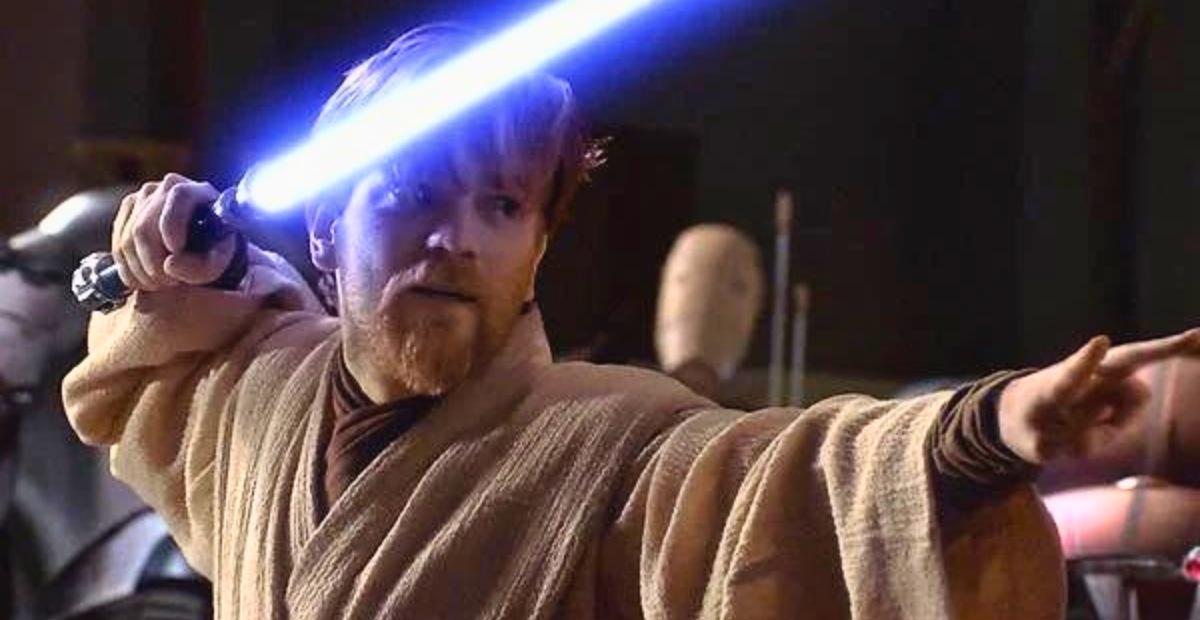Like me, you’ve probably noticed Obi-Wan Kenobi always slipping into that same iconic stance before a fight — lightsaber raised back, two fingers pointed forward. It’s not a random quirk or a throwaway flourish. That pose carries layers of meaning, both behind the scenes and in the story itself. Here’s what’s really going on.
It Started as a Cinematic Choice That Became His Signature
During the prequels, stunt coordinator Nick Gillard and the fight team wanted every Jedi to have a distinct fighting personality. Obi-Wan’s style was designed to feel precise and controlled, and the two-finger guard became part of that visual language.
Ewan McGregor leaned into the pose, and once it showed up on screen, it stuck. It wasn’t originally some ancient Jedi salute — it was there because it looked striking, read clearly on camera, and helped define Kenobi’s character. Over time, it became so closely tied to him that later series, like Rebels, kept using it as a visual shorthand: “This is Obi-Wan, the calm, defensive master.”
In-universe, Obi-Wan is known as the foremost practitioner of Form III: Soresu, a lightsaber style built on endurance, patience, and precision. Its core idea is simple: conserve energy, let your opponent make the first move, and exploit their mistake.
That’s exactly what the two-finger stance signals. It’s open but measured, showing readiness without aggression. The blade stays close to the body, minimizing exposed angles, while the extended hand acts like a sensor — controlling range, focusing attention, and visually saying, “I’m prepared, but I’m not rushing in.” This defensive focus is why Kenobi consistently outlasts stronger or more aggressive opponents, from Darth Maul to Anakin Skywalker.
It’s Rooted in Real Martial Arts — Especially Jian Swordwork
There’s also a deeper layer behind that gesture. The stance strongly resembles the “sword fingers” used in traditional Chinese sword arts like taijijian (Tai Chi sword). In those systems, the non-sword hand often extends two fingers — the index and middle — for several reasons:
- Energy focus: The fingers symbolize yin and yang, helping the practitioner direct intent and internal power (qi) through the weapon.
- Balance and control: Extending the off-hand counterbalances the sword and sharpens spatial awareness. This idea of harmony between opposing forces closely reflects Jedi philosophy, which teaches balance between passion and peace, strength and serenity, and ultimately between the dark and light sides of the Force.
- Range awareness: The fingers can “feel” the distance, guiding blade positioning with precision.
Whether or not Nick Gillard explicitly borrowed from taijijian, the similarity is no accident. The pose mirrors centuries-old sword traditions that combine practical technique with deep symbolism — and that same balance-centered thinking runs through the Jedi way as well, giving Obi-Wan’s fighting style a grounded, authentic feel.
It’s Also a Tactical and Psychological Tool
Obi-Wan’s two-finger pose isn’t just for show. It’s a mental and strategic device that shapes how a duel unfolds.
Standing calmly with an open guard can unsettle opponents who expect aggression. It projects confidence — even superiority — without saying a word. More importantly, it helps Obi-Wan stay centered and patient, forcing his enemies to commit first.
A great example comes from the Star Wars Rebels episode “Twin Suns.” Obi-Wan shifts between three stances in just seconds: his classic Soresu pose, the older stance from A New Hope, and finally the one Qui-Gon used against Maul in The Phantom Menace. This last switch baits Maul into repeating the same mistake — a fatal overcommitment — and Obi-Wan ends the duel in one decisive strike. The stance isn’t just tradition here; it’s a trap.
What’s interesting is that the two-finger pose isn’t fixed. Over the decades we see Kenobi adapt and evolve. In the prequels, it’s often a standard part of his defensive setup. In Rebels, it becomes something more subtle — almost ceremonial — as he matures into a Jedi who no longer fights unless absolutely necessary. The fact that he still uses the gesture shows how deeply it’s tied to his approach: calm, patient, strategic, and precise.

